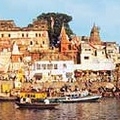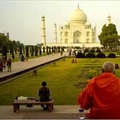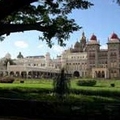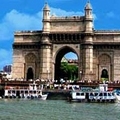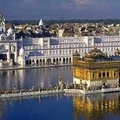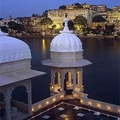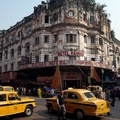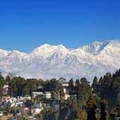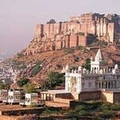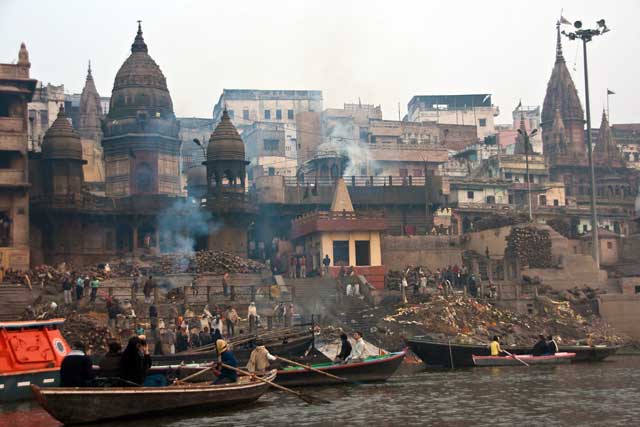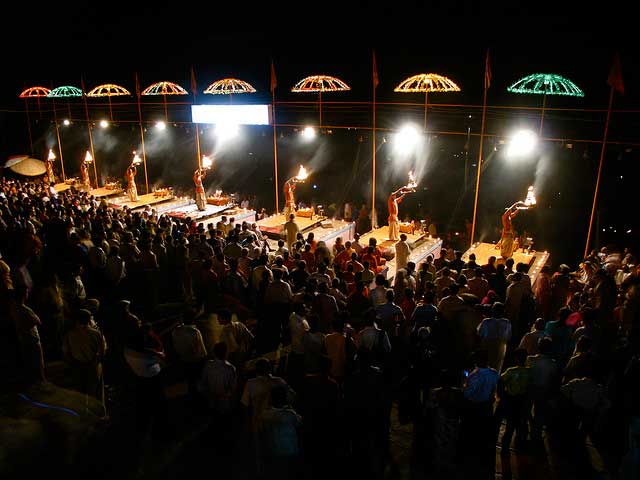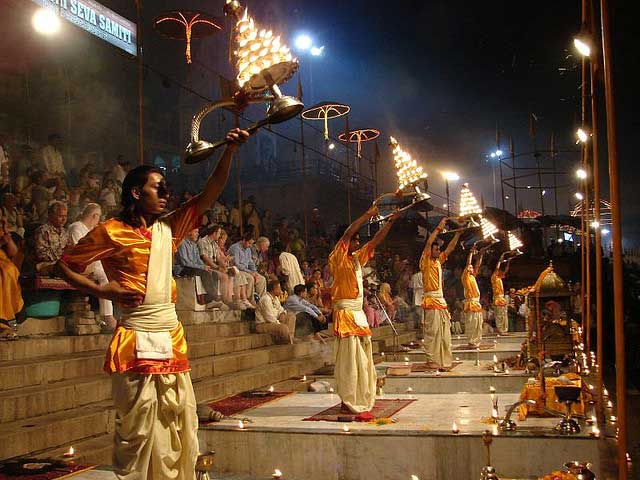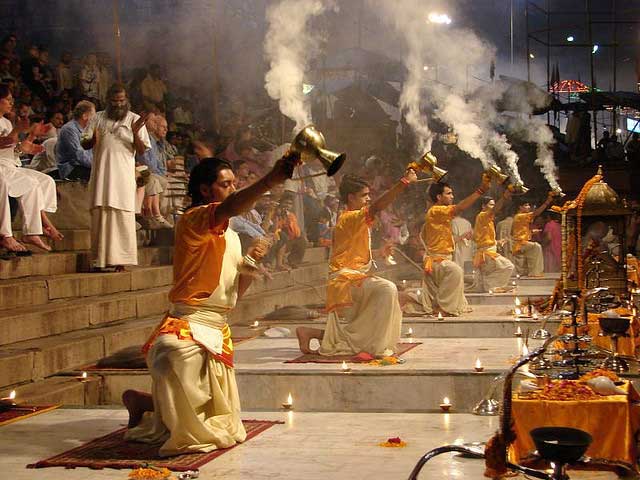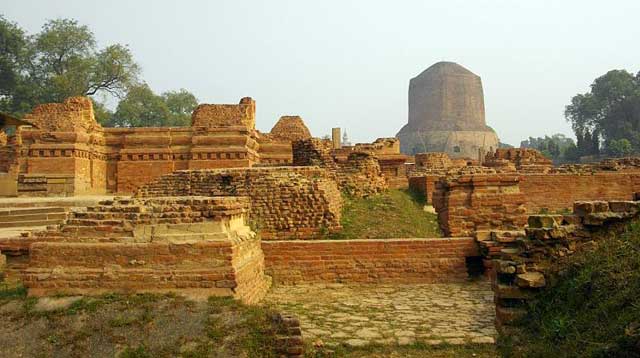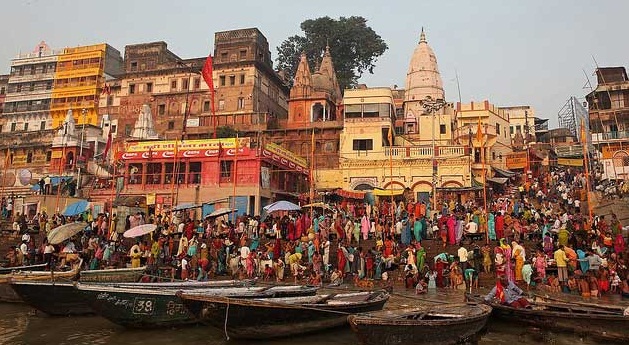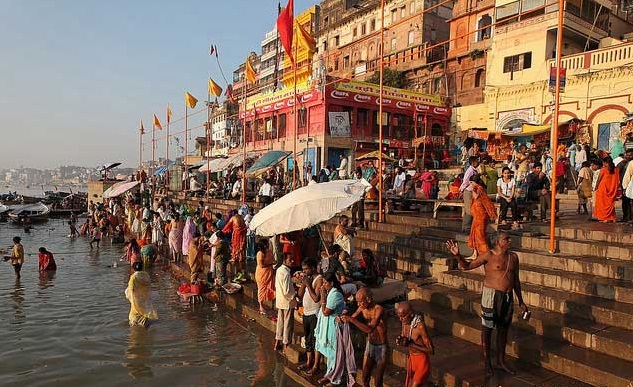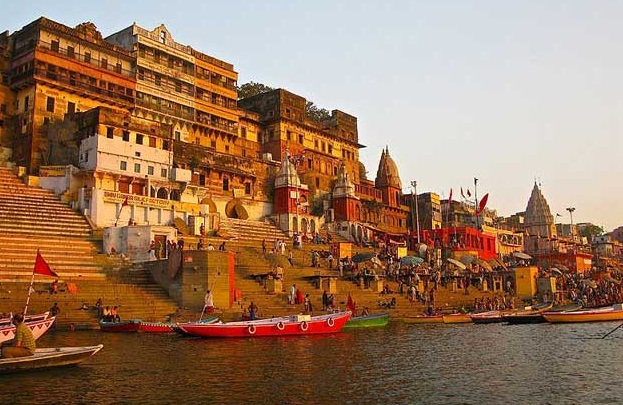Destinations / The Best Cities to Visit in India / Varanasi - The City of Life and Death
Varanasi - The City of Life and Death
When the first rays of the morning sun rose on the banks of the River Ganges, an old man holding out his hands towards the ball of fire slowly rises and says "namaste" (adoration and glorification of God). Such scenes are repeated every day for more than three thousand years in Varanasi, the holy city of India. Watching the scene on the banks of the River Ganges, the impression of the city freezes in time.
Varanasi is an important religious site in the world of Hindu pilgrimage center of Hindus from all over the world, such as ancient as Babylon and Thebes. It is stronger than elsewhere, manifested contradictions of human existence: life and death, hope and suffering, old age and youth, joy and despair, light and poverty. It is a city in which so much of death and life happen simultaneously. It is a city where these two co-exist forever. This is the best place for an understanding of what constitutes India, its religion and culture. In the religious geography of Hinduism, Varanasi is the center of the universe. One of the most sacred cities for Hindus as a kind of interface between the physical reality and the eternity of life. Here the gods descend to the Earth and reaches a mere mortal bliss. This is a sacred place to live and a blessed place to die. This is the best place to reach bliss. The fame of Varanasi in Hindu mythology has no equal. According to the legend, the city was founded by the Hindu God Shiva, a few thousand years ago, making it one of the most important pilgrimage sites in the country. This is one of the seven sacred cities of Hindus. In many ways, he embodies the best and worst aspects of India, sometimes leading foreign tourists in horror. Nevertheless, the scene of pilgrims, uttering a sunrise prayer by the river Ganges, on a background of Hindu temples is one of the most spectacular sights in the world. Traveling to northern India, you cannot try to not pass by this ancient city.
Founded over a thousand years before Christ, Varanasi is one of the oldest cities in the world. It was named by many epithets - " the city of temples", "the holy city of India", "the religious capital of India", " the City of Lights," " The Education City" - and only just recently been restored to its official name was first mentioned in the Jataka - an ancient story Hindu literature. But many people still continue to use the English name of Benares and the pilgrims are called to it as Kashi - so the city was called three thousand years. Throughout the centuries, Varanasi has been a center of philosophy and theosophy, medicine and education. The British writer Mark Twain was shocked visiting Varanasi and he wrote: "Banaras (the old name) over the history is older than tradition, older even than its legend and looks twice as old as all of them together." Many well-known and most respected Indian philosophers, poets, writers and musicians have lived in Varanasi. In this glorious city lived a classic Hindi literature Kabir, Tulsidas poet and writer, wrote an epic Ramacharitamanasa, a voluminous poem, which became one of the most famous works of literature in Hindi, as the Buddha delivered his first sermon at Sarnath, just a few kilometers from Varanasi. Sung by myths and legends, hallowed by religion, it always attracted a large number of pilgrims and worshipers from time immemorial. Varanasi is located between Delhi and Calcutta on the west bank of the Ganges. Every Indian child, listening to the stories of their parents, knows that the Ganges is the largest and the most sacred of all rivers in India. The main reason for visiting Varanasi is, of course, to see the river Ganges. The value of the river for Hindus is beyond description. It is among the 20 largest rivers in the world. The river basin of the Ganges is the most populous in the world with a population of more than 400 million people. Ganga is a major source of irrigation and communication for millions of Indians living along the river. Since time immemorial, it was worshiped as the goddess Ganga. Historically, that several former princely capitals are located on its banks. For devout Hindus, the Ganges River meant the same thing as the earth goddess Gaia to the Greeks: the giver of life, help and salvation. Hindus regard the River Ganges as amrita, the elixir of life, which brings purity of life and salvation of the dead. Religious beliefs of Hindus urge them to make a pilgrimage to Varanasi at least once during life. Hindus believe that the river Ganga flow to the Earth from heaven to wash away the worldly sins of mortals. Therefore, the entire life of the town is centered around the holy river. Shortly before the sunrise, the bank of the Ganges comes alive when thousands of pilgrims - men, women and children come down to the river to meet the rising sun and then dive into a holy river to cleanse them from their sufferings and wash away their sins. Every day, more than 60,000 people come to the river to plunge into the sacred waters of Ganges offering up their prayers to the forces of nature, the rising sun, dead ancestors, gone with the sacred waters of the river. People are attracted to the river to a firm belief that the water can remove the sins of many generations. Each person makes his own ritual of touching the sacred Ganges: some swimming, others drink water and others present in the water sacrifices in the form of flowers, fruits and take pots filled with holy water to take to their homes to perform religious rituals.
Varanasi is best known for its ghatam - an endless chain of stone steps descending to the water. Each of the approximately 100 Ghat, large and small, has a lingam (male organ of Shiva) and occupies a special place in the religious geography of the city. Some of them fell into disrepair over the years, others continue to take the early morning swimmers. Some Ghat covered with legends and myths, some are already in private ownership. Most are used for bathing ghat, several of them are used for cremation. At all times, pilgrims came to the city from all over India , even a few thousand miles to bathe in the Ganges, cleansed of sin and death ... in order to quickly be exalted to heaven. Death is a good business in Varanasi. The weak, the sick and the elderly come to the city in anticipation of death. Dying in the city on the banks of the river of life is to die with the hope of salvation, with the hope of deliverance from the endless cycle of life and death (reincarnation), and obtain Moksha, that is eternal bliss. Thus, for centuries, Hindus have come to Varanasi to die or bring the ashes of the dead, in order to dispel over the holy waters of river Ganga.
Devouted Hindus regard cremation as an important rite of liberating the soul from the body, allowing the dead to rise to heaven. In the traditional culture of the Indians when a person dies, the body of the dead was ritually washed, the corpse is burned at the stake, then the family dispersed over the ashes of the holy river. In Varanasi from 200 to 300 bodies a few ghat along the river are ritually cremated each day. The cremation of dead bodies takes place 24 hours a day. The dead are taken on bamboo stretchers through the streets of the old town and then dipped into the river and only then burned. The bodies are wrapped in cloth and covered with a brilliant garlands of flowers. To hide the smell of burning, bodies are thrown into the fire of incense. Tourists can watch the ceremony of cremation, but they should be dressed properly. It is not allowed to make pictures. Manikarnika-Ghat Children died till the age of 10, the bodies of pregnant women and patients with smallpox are not cremated. They tie a stone to their bodies and threw them from a boat in the middle of the river Ganges. The same fate awaits those whose families cannot afford to buy enough wood. The cremation at the stake is worth a lot of money and not everyone can afford it. Sometimes the wood purchased is not always enough for cremation and then the remains of the body are dumped into the river. It is quite common to see the charred remains of dead bodies floating in the river. It is estimated that each year in the city are buried at the bottom of the river about 45 000 are not cremated bodies, increasing the toxicity of the already heavily polluted water. What is shocking to western tourists visiting seems quite natural for the Hindus. Unlike Europe where everything happens behind closed doors, every aspect of life in India can be seen on the streets, whether cremation, laundry, bathing or cooking. The river Ganga is miraculously able to clean itself for many centuries. Even 100 years ago, microbes, such as cholera, could not survive in its sacred waters. Unfortunately, the Ganges is one of the five most polluted rivers in the world. In the first place because of the toxic substances discharged by industrial enterprises along the river. The level of contamination of some microbes exceeds the allowable rates hundreds of times. Tourists' eyes catch a complete lack of hygiene. The ashes of the dead, sewage effluents and donations are sailing past the believers when they are swimming in the water and hold a ceremony of purification. From the medical point of view, swimming in the water in which the decomposed corpses bear the risk of infections with multiple diseases, including hepatitis. This is a miracle that so many people daily dip and drink water and suffer no harm. Even some tourists join the pilgrims.
Ganga Arati
One of the most fascinating sights of Varanasi takes place every evening at the ghat Dashashvamedh. A group of young Hindu priests - Brahmin performs arati - a kind of ritual in Hinduism, with lighted candles, during which present with gifts: incense, flowers, fruits and more. The colorful 45-minute ritual is worship of Shiva, the sacred Mother Ganga, Surya (Sun), Agni (fire), and the entire universe. Arati ritual is extremely entertaining. Thousands of people attend the ceremony, including many tourists. According to the legend, Varanasi was founded by the Hindu god Shiva 5000 years ago, although modern scholars believe that its age is estimated about three thousand years. The city was under the control of Hindu rulers over many hundreds of years before the end of the 12th century, when fell into the hands of a number of Muslim conquerors. The result was the complete destruction of Hindu and Buddhist temples and building on their place of Muslim mosques. Therefore, the age of the old buildings and temples of Varanasi dates back to 18th century. And yet a sense of ancient history here is quite palpable. Mazes of narrow streets filled with pilgrims who buy flowers for the puja (prayer), grieving relatives carrying the dead and the singing of the clergy - the impression that is impossible to forget. However, familiarity with the city has two sides. Roads full of cars and trucks, buses, rickshaws, bicycles, carts, people, goats, cows and buffaloes. The hot air is polluted enormously. Narrow streets in very poor condition, often lack sidewalks, sacred to Hindus, cows scavenge garbage in the street. From noise and odors can go head around. Varanasi is impressive and shocking at the same time.
Silk products
Varanasi is famous for its manufacture of silk products which are an integral part of the dowry of every Indian girl. Made in Varanasi brocade has historically been considered one of the best in India and is well known throughout the world. Its feature is the embroidery of gold and silver threads. These products are relatively heavy due to the fact that the pattern is decorated with gold and silver threads. Depending on the complexity of the designs and models, to make a sari takes 15 days to one and sometimes up to several months. The fabrication technique is very complicated and requires much experience. In the business the whole family are involved, children begin to learn the basics of art from an early age. Traditionally, over the centuries, the Muslim community in the city made silk. Produced in Varanasi silk fabrics can be found in every corner of India, their quality is generally recognized: they say that the body of the Buddha was wrapped in a shroud of silk, manufactured in Varanasi. Enterprising businessmen rickshaws and drivers are out to drag tourists into shops to then get a commission. So shopping in Varanasi could turn into a nightmare, but the quality of textile products is worth it.
Sarnath
Take the opportunity and be sure to visit Sarnath. It is located about 10 km from Varanasi and is known as the place where Buda, reaching enlightenment preached his first sermon about 2,500 years ago. For over 1,000 years, Sarnath has attracted many pilgrims, there were about 3000 monks, it was an important center of Buddhist learning. But the constant Muslim invasions and looting have destroyed the monasteries and their wealth in the late 12th century. Rebuilt in the late 19th century, today it still attracts many pilgrims, but from the ancient buildings are preserved only a pile of bricks from the demolished monasteries and stupa Dhamek. Built around the year 500, a height of 31 m, stupa, as they say, means the place where the Buddha told his Eightfold Path, leading from the end of the eternal human suffering to nirvana.
Dhamekh Stupa
Varanasi is best to visit during the celebration of Deepavali. On the 15th day of Diwali, at dusk, every ghat illuminated with lights, thousands of candles are floating on the River Ganges, followed by the singing of Vedic hymns. It is believed that the gods descend from heaven to bathe in the river on this occasion. In the period from April to October the weather is very hot and humid. In July and August often rains, thick fog envelopes the city in December and January.
Others The Best Cities to Visit in India .
Maps of Varanasi - The City of Life and Death
map IndiaOthers from The Best Cities to Visit in India
You can stay at different hotels and chalets in India, which are available in abundance.
You can even opt for holiday rentals apartments which can be found in all towns.
There are various holiday villas in many cities to promote tourism.
Here, we present the top cities with landmark tourist spots as well.
Geographical position India is a country in South Asia.
India is the 7th place in the hierarchy of countries by area, second only to the number of inhabitants and democracy to most people.
Neighborhood India has a coastline with a length of seven thousand kilometers and the western border with Pakistan, Nepal, China, Bhutan and Bangladesh in the northeast and Mynmar in the east.
In the Indian Ocean, it is adjacent to Sri Lanka, Maldives and Indonesia.
The Relief India has three natural regions: the region of high mountains, Indo-Ganges Plain and the Deccan Plateau.
The region of high mountains in the north and northeast of the country comprises most of the Karakorum Mountains and part of the Himalaya Mountains.
High mountains covered with snow are persistent, there are many glaciers which are strongly fragmented by rivers.
Indo-Ganges is an alluvial plain, low and smooth.
The landscape is formed from the large Indian peninsular Deccan Plateau with sharp edges which are based on coastal plains.
The most important river of India is the Ganges.
Climate The climate of India is tropical monsoon with different shades, depending on the altitude and the available relief.
In the Northeast and in some areas protected from the wind very little precipitation falls on the Deccan Plateau, western slopes of Western Ghat region at the foot of Himalaya receive a large amount of precipitation.
Tourism Home of the Hindu civilization of the valley, the center of trade routes and vast empires, India has played a major role in the human history.
Brahmanism, Hinduism, Sikhism, Buddhism and janismul originated in India, while Islam and Christianity enjoy a rich tradition here.
Colonized as part of the British Empire in the nineteenth century, India gained independence in 1947 as a unified nation after sustained effort made in this direction.
Population, creatures,the geographical and climate system are among the most diverse in the world.
You may also remember that India is the home of pepper.

